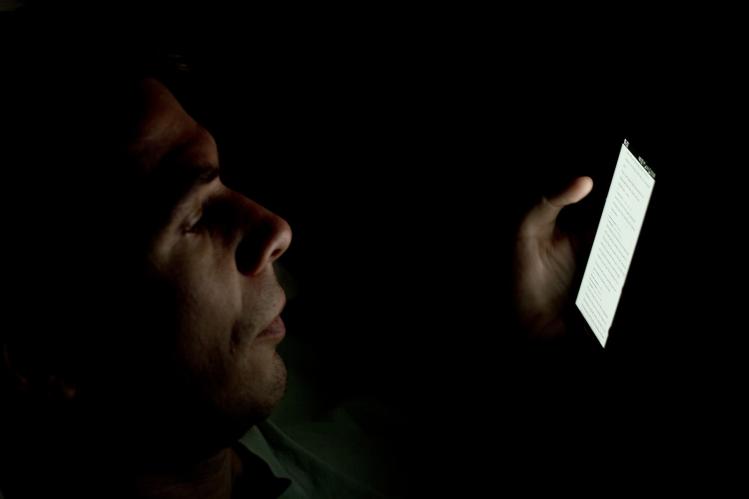
The four-year-old riding in the elevator with her mom was coming from a party and covered with glitter. Apparently she’d been asking her mom about the sparkly stuff, because as I entered, the mom had just googled it on her smartphone and was delivering a tidy mini-lecture on the history, science, and cultural significance of glitter. I listened, and twenty seconds later, I left the elevator edified, via a small packet of information zapped up on the device Apple inaugurated a decade ago this fall.
Such casual enrichments testify daily to the fathomless powers of information and communication that smartphones bring to our literal fingertips at all times. That power manifests itself not only in small-bore moments like the one I observed in the elevator, but in mass collective actions. Take the current remarkable toppling of powerful men for sexual harassment. This viral phenomenon reflects a great deal of pent-up torment suffered by women worldwide. And it’s crystal clear that social media have been crucial—a simple hashtag gets launched on Twitter, and a global movement for social justice is unleashed.
I offer these tributes as a necessary concession. I’m a smartphone refusenik, and a vehement one at that. Anyone attempting to stake out an oppositional stance on a transformative technology, however, has to begin by acknowledging the upside of that technology—which, with the smartphone, is both impressive and ubiquitous. Yet what about the downside? What are we giving up in exchange for what we’re getting? Hardly a day passes without my thinking that what I have elsewhere called “the smartphone bargain” is a bad deal, even a calamitous one. (And I have said so here and here and here.)
Readers of my jeremiads on this topic have responded with three interconnected points: 1) technological change is irreversible, so get used to it; 2) the skeptic takes the innovations of the past for granted while complaining about the disruptions of the present, which makes his critique incoherent; and 3) all major technological innovations are disruptive. Taken together, these arguments suggest that in opposing a powerful technological innovation, you’re being blinkered, hypocritical or just plain foolish—the hapless neo-Luddite, ignoring the matrix of technological innovations over the last 500 years that created the “normal” to which he is clinging. We wouldn’t want to go back to the fifteenth century, would we?
Of course not; and no one, least of all yours truly, is lamenting the widespread loss of, say, horse-shoeing skills, or celestial navigation—that whole basket of skills made obsolete by technological innovations. But some new technologies are more disruptive than others—some way more disruptive. And by disruptive I mean something quite specific: transformational with respect not just to human work, but to the human being, in fundamental social, personal and even cognitive categories. An automatic dishwasher is one of many labor-saving devices that provide a nifty convenience without being particularly transformative of us, of how we are with each other and with ourselves. Yet the smartphone revolution is doing precisely that. That’s why it’s a revolution, and not merely a helpful gadget.
Just how transformative is the focus of several recent articles and reports. Last month a cover story in the New York Times Magazine article asked, “Why Are More American Teenagers Than Ever Suffering from Severe Anxiety?,” and quickly zeroed in on a prime culprit: social media. I was not surprised to hear teenagers express a worried preoccupation with how they’re being presented and judged by their peers out there in cyberworld. My wife is a middle-school counselor, and almost every day she tells me how drastically social media amplify the fraught dynamic of exclusion and judgment that is so often a pervasively excruciating force in adolescence. (Girls seem to be especially hard hit.)
But even more interesting to me was the comment, by the clinical director of an Oregon mental-health institute specializing in anxiety, that smartphones give teens what he called the “illusion of control and certainty,” enabling them to “manage the environments” of daily life. “Teens will go places if they feel like they know everything that will happen, if they know everyone who will be there, if they can see who’s checked in online,” he said. “But life doesn’t always come with that kind of certainty, and they’re never practicing the skill of rolling with the punches, of walking into an unknown or awkward social situation and learning that they can survive it.” They’re being disabled, in other words, for the normal vicissitudes and unpredictability of life. That “skill of rolling with the punches,” also known as resilience, or grit, represents a value our culture purports to cherish. Yet even as we extol it, the technology we rely on is undermining it.
Further perspective comes in an Atlantic article bluntly titled “Have Smartphones Destroyed a Generation?”, by Jean M. Twenge, a San Diego State University psychologist who researches adolescent mental health. Twenge christens the cohort of children born between 1995 and 2012 “iGen,” to denote a generation “shaped by the smartphone and the rise of social media.” Noting that three out of four American teens currently owns an iPhone, she asserts that “the impact of these devices has not been fully appreciated, and goes far beyond the usual concerns about curtailed attention spans.” She continues:
The smartphone has radically changed every aspect of teenagers’ lives, from the nature of their social interactions to their mental health. These changes have affected young people in every corner of the nation and in every type of household. The trends appear among teens poor and rich; of every ethnic background; in cities, suburbs, and small towns. Where there are cell towers, there are teens living their lives on their smartphone.
And what, in Twenge’s view, are the hallmarks of life lived on the smartphone? An anxious timidity. A steep decline in dating and in the capacity for unmediated intimacy. Higher rates of loneliness and of depression. Difficulty sleeping. A homebody inclination that can verge on agoraphobia—since all social life can be “managed” via the phone, from one’s room. iGen kids work less, go out less, hang out less with friends, play fewer sports, and spend way less time outdoors. “So what are they doing with all that time?” Twenge asks. “They are on their phone, in their room, alone and often distressed.” Interviewing one teen about what she did all summer, she learns that the girl spent much of it keeping up with friends via text and Snapchat. “I’ve been on my phone more than I’ve been with actual people,” she said. “My bed has, like, an imprint of my body.”
The substitution of virtual friendship for physically-present friendship hasn’t been salutary. Twenge cites surveys that have posed a set of life-quality questions to high school seniors annually for the last forty years. “The results could not be clearer: Teens who spend more time than average on screen activities are more likely to be unhappy, and those who spend more time than average on nonscreen activities are more likely to be happy.” Twenge acknowledges that “no single factor ever defines a generation.” That said, she goes on: “It’s not an exaggeration to describe iGen as being on the brink of the worst mental-health crisis in decades. Much of this deterioration can be traced to their phones.” And: “The twin rise of the smartphone and social media has caused an earthquake of a magnitude we’ve not seen in a very long time, if ever.”
It isn’t just what’s going on among and around smartphone users, moreover, but inside them. NPR’s On Point hosted a discussion under the title “How Smartphones are Draining Our Brain Power,” that delved into research, conducted by neuroscientists at the University of Texas, showing that the mere presence of one’s smartphone in his or her vicinity – even when turned off – substantially detracted from the ability to focus and think. The researchers summed up: "As the smartphone becomes more noticeable, participants' available cognitive capacity decreases. Your conscious mind isn't thinking about your smartphone, but that process—the process of requiring yourself to not think about something—uses up some of your limited cognitive resources. It's a brain drain." That conclusion is buttressed by research detailing the neurochemical side of this action, the dopamine rush we get each time the little ping! announces an incoming text. The language of addiction, in other words, is no mere metaphor; it’s a clinical judgment.
But you don’t need scientific articles in order to understand any of this. Just look around. In a few short years, we’ve become a nation of smartphone zombies, heads ever bent over our devices, fingers incessantly swiping away. Flick, flick, flick; swipe, swipe, swipe. Research shows that college students spend 8-10 hours a day on their phones. Teachers tell of students exhibiting rage when forced to give up their phones in class. Isn’t it painfully obvious that digital distraction has become digital dependency? Why else would a person endanger himself and others, and risk stiff fines, to get his texting fix while driving a car?
That’s probably the most dangerous aspect of distraction sickness, but to me it’s not the most dismal. Recently I went to the gym with my eleven-year-old for a swim. On our way out, as we joked around with each other, a guy and his young son were coming in—both sunk in their cellphones. I felt like shaking him. You’ve got a few precious years to spend with your kid, and this is how you’re doing it?
This is why handhelds are different from past innovations. The traditions being wrecked by our devices aren’t merely older technologies (the horse-drawn carriage, the sextant), but fundamental modes of being human: our conversation, and evidently our cognition itself. And our solitude. All the idle moments during a day, when we used to be alone with our thoughts, are being decimated, and gradually a crucial meditative dimension in our lives is disappearing; soon there will be no lull, just a ceaseless stream of input. Thanks to Twitter, Facebook and the rest, we’re never really wholly with others anymore, and we’re never really alone, either. We’re elsewhere and nowhere. We’re nibbling our way through our lives, following this little scatter of bits deep into the digital forest. Where will it lead?
One index of how disruptive a technology is is the question of how discrete its use is. Can you deploy it to do a task, then put it away until the next time you need it? The signature aspect of the smartphone is its near-continuous use. It is this constant use—the way that the device has become annexed to the self, both the social self and the self in solitude—that’s so striking. If the devices were being used simply as tools for discrete problem-solving actions, that would be one thing. Texting your friend to let her know you’re running late, cheating on crossword puzzles, finding that recipe—all good! My recurring fantasy is that digital-device use could be limited to a few specific times during the day: you’d fire it up, fetch whatever information and communication you needed, then shut it down. But almost no one does this. Once you have a handheld, the all-but-irresistible pattern is to use it more and more, until effectively it is using you. I remember when the Today Show discussed digital dependency last year, the hosts looked at each other with hangdog guilt, whereupon co-host Hoda Kotb announced a bold new policy she’d undertaken. “When I get up in the morning, I don’t even look at my phone for ten minutes!” she enthused, as Matt and Savannah marveled.
The smartphone refusenik understands that he’s fighting a battle he can’t win. You might as well try to inveigh against weather. But I’m struck by the disparity between the overwhelming triumph of the smartphone and the paucity of advocates for it. Very rare is the parent who’s willing to say “I know that my child has installed her digital device as a part of her self, and is profoundly dependent on it... and all in all, I think that’s beneficial.” What you tend to get instead is a wince and a look that says, “I basically agree with you, but what can I do?” And what can parents do, when most of them are addicts themselves? But the mere fact that everybody has a problem doesn’t make it less of a problem. Even kids themselves lament where their phones have taken them, the demands the technology makes. The teenage son of one of my best friends recently told me, “I basically hate my phone most of the time. I really wish they didn’t exist. But they do.”
Some months ago, in New York Magazine, the author and blogger Andrew Sullivan published a rueful confessional essay, “I Used to Be A Human Being,” describing how he became “a manic information addict” captive to social media’s nonstop chores and rewards. Sullivan’s confession charts the toll taken by what he calls his “distraction sickness.” “It broke me,” he writes; “and it might break you too.” Indeed, it might break almost anyone. And not just here. Last year the Washington Post ran an article titled “In China, Smartphones are Wrecking Marriages and Dividing Families,” quoting a women’s group, the All China Women’s Federation, calling handhelds “a major enemy to spousal relations, parental relations and personal health.”
You go, ACWF! Hang tough! For my part, no matter how futile the cause, I’m going to remain a tireless evangelist for the Church of No Devices. I’m basically a middle-of-the-road guy on most topics, and so I find it strange to be a fanatic, the voice crying in the wilderness. But I really and truly just don’t get it. Why does everyone think that being chained to a device that disrupts our conversations, devours our solitude, compromises our safety on the roads, compels our gesture of fealty in a compulsive flicking tic, and induces an anxious sense of incompleteness when we try to put it down, is such an awesome idea? It’s as if, within a single decade, an alien force took all of humanity into captivity, enslaving us via remote control devices placed in our hands... and no one cared. This will never cease to astonish me. How did we go without even a peep?
The other night on NBC News, Lester Holt interviewed Apple CEO Tim Cook for a preview of the iPhone 10, whose dazzling new features include face recognition. With complacent wonder, the two men looked back at a decade of smartphones. Has the device lived up to expectations? Holt asked. What exactly had Steve Jobs, Cook himself, and others at Apple envisioned back then?
Cook grinned. “We knew from the launch that it was going to change the world. But it has gone far beyond what we dreamed.”
You can say that again.
As for me, I have an action plan and a dream of my own. My action plan, beyond gloating gleefully whenever I see someone being ticketed for texting while driving, revolves around my sixth-grade daughter, with whom my wife and I have pursued a stringent policy: no smartphone until you’re sixteen. Our goal has been to try to insure that she gets wired, cognitively, for sustained focus and for negotiating complex language in print, instead of for the jittery, ever-shifting cognition and attenuated language of the digital world. I don’t think it’s an accident that she is a voracious reader, the kind who gets so immersed in a novel that you have to jostle her to get her attention. Her pushback against our smartphone prohibition so far has been minimal, though I expect it to increase soon enough. But honestly, our work there is basically done.
As for my dream... the other day I heard a radio interview with Mike Moore, the Mississippi lawyer who was a driving force behind the class-action lawsuit against tobacco companies two decades ago. Moore is currently undertaking a similar effort against the pharmaceutical firms that, in his view, fostered the opioid epidemic we’re now suffering. Moore perfected the legal art of taking on powerful corporate interests whose addicted products have enslaved and sickened Americans. Big Tobacco. Big Pharma. And I would like to add: Big Phone. It meets the criteria: a product that has massively addicted the populace, at a significant cost to public health; and has done so, moreover, with the knowing complicity of its corporate masterminds. At least with Big Tobacco, all the executives smoked—at least they did for the first 30 years or so. But the lords of Silicon Valley? Their kids are getting an artisanal, hand-tooled education at elite private academies where smartphones and laptops are not allowed. So what do they know that they’re not telling us?
Look out, Big Phone! Some day that swipe, swipe, swipe is coming right at you.
Please email comments to [email protected] and join the conversation on our Facebook page.
Previous Story
Was It Better Back Then?
Next Story
The Rich Keep Themselves Rich

